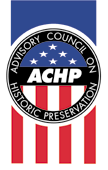 About ACHP
About ACHP ACHP News
National Historic
Preservation
Program
Working with
Section 106
Federal, State, & Tribal Programs
Training & Education
Publications
Search
Home
Advisory Council on Historic Preservation Launches New Look and Organization
Washington, DC—The Advisory Council on Historic Preservation launched a new look and organization at its winter business meeting March 1, 2002, in Washington, DC.
Under the leadership of presidentially appointed chairman John Nau, ACHP's existing members and staff are reorganized into three major program areas—Preservation Initiatives, Federal Agency Programs, and Communications, Education, and Outreach—to better meet all needs of the historic preservation community and the Nation. An Executive Committee oversees all ACHP work.
The agency's reorganization is complemented by a dynamic new logo that was unveiled at the meeting.

ACHP's new logo was unveiled at the winter 2002 business meeting. The new image complements the agency's new structure, which focuses on three major program areas to better serve the historic preservation community and the Nation. Pictured are Chairman John Nau and Executive Director John Fowler.
An independent Federal agency, ACHP was created by the National Historic Preservation Act of 1966. ACHP serves as primary policy advisor to the President and Congress on historic preservation matters, leads the Nation's historic preservation program, and administers the Federal Government's protective process for historic properties.
Committees Govern New Organization
Under ACHP's new structure, an Executive Committee, headed by Chairman Nau and Vice Chairman Bernadette Castro, governs agency operations such as management, budget, legislative policy, and oversight of prominent Section 106 cases.
The Executive Committee is composed of the Chairman, Vice Chairman, and
ACHP members who chair three standing committees that correspond to ACHP's
three new program areas. The staff structure has been realigned to support
the new program areas, which are:
- Preservation Initiatives focuses on policy recommendations
and implementation of ACHP-adopted policies; program initiatives such
as heritage tourism; and partnerships to promote preservation with groups
such as State and local governments, Indian tribes, and the private
sector.
The Preservation Initiatives Committee is composed of Mayor Bob Young, chair; general public member Carolyn Brackett; historic preservation expert member Arva McCabe; Kelly Sinclair, Environmental Protection Agency; Linda Lawson, Department of Transportation, and Ted Sanderson, National Conference of State Historic Preservation Officers.
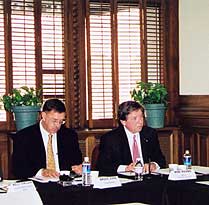
Mayor Bob Young (right), chair of the Preservation
Initiatives Committee, presents recommendations from his committee to
the full membership at the business meeting. At left is Bruce Judd, historic
preservation expert member.
- Federal Agency Programs continues ACHP's traditional role
of administering the National Historic Preservation Act's Section 106
review process and working with Federal agencies to help improve how
they consider historic preservation values in their programs.
The Federal Agency Programs Committee consists of general public member Kak Slick, chair; historic preservation expert member Bruce Judd; Native Hawaiian member Ray Soon; Lou Gallegos, Department of Agriculture; Dick Moe, National Trust for Historic Preservation; Alan Hantman, Architect of the Capitol; and Philip Grone, Department of Defense.
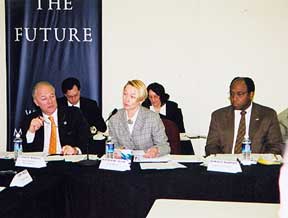
Federal Agency Programs Committee chair Kak Slick reports the recommendations from her committee at the meeting. At the table from left to right: Joseph Moravec, Public Buildings Commissioner, General Services Administration; Kak Slick, general public member; and Donald Murphy, Deputy Director, National Park Service.
- Communications, Education, and Outreach conveys ACHP's vision
and message to constituents and the general public through public information
and education programs, and a public recognition program for historic
preservation achievement.
The Communications, Education, and Outreach Committee is composed of National Park Service Director Fran Mainella, chair; historic preservation expert members Jim Huhta and Parker Westbrook; Governor Jane Dee Hull; and Joseph Moravec, General Services Administration.
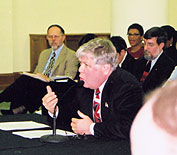
ACHP staff look on as Dan Smith, Special Assistant to the Director of the National Park Service, presents findings from the Communications, Education, and Outreach Committee at the meeting. Smith represented National Park Service Director Fran Mainella as chair of the committee.
Prior to ACHP's business meeting, each committee met to discuss the tasks of its program area and explore new directions for the agency. At the business meeting, each committee chair presented these recommendations to the full membership for its consideration.
Washington Monument Security, Proposed Executive Order Also Discussed
In addition to the work done by the committees to develop and advance a number of initiatives, members took the following actions at the business meeting:
- heard recent activities of ACHP's Task Force on Homeland Security and Historic Preservation, which responds to the National Capital Planning Commission's report, Designing for Security in the Nation's Capital. Members also heard a presentation by design firm Olin Partnership, which outlined its proposal for security improvements and enhanced visitor services at the Washington Monument. The Task Force later toured the Washington Monument for a firsthand look at the proposed measures.
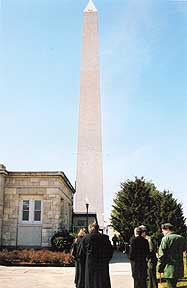
Following the business meeting, members of ACHP's Task Force on Homeland Security and Historic Preservation received a firsthand look at the proposed security enhancements and enhanced visitor services for the Washington Monument in a site visit conducted by the National Park Service.
- endorsed the Draft Guidance for Security Measures Affecting Historic
Places for transmittal to the National Park Service director.
-
endorsed a proposed preservation Executive Order and requested comments from Federal agency members.
-
adopted an approach to drafting technical Section 106 regulation amendments to respond to the September 2001 court opinion.
About the Members
John Nau, III, of Houston, Texas, chairs ACHP, whose membership includes four historic preservation experts, four citizen members, a Native Hawaiian, a governor, a mayor, and four Federal agency heads, all appointed by the President. The Secretaries of the Interior and Agriculture, the Architect of the Capitol, the president of the National Conference of State Historic Preservation Officers, and the chairman of the National Trust for Historic Preservation round out the membership. John M. Fowler serves as Executive Director. ACHP is headquartered in Washington, DC, with an office in Denver, Colorado.
Updated
May 2, 2002